Among various types of birds, seeing those that have visible, elongated body parts is a sight to behold. Long legs are usually a distinctive feature of waterbirds, such as wading birds, shorebirds, and some species of herons.
The unique birds with long legs are:
the Sandhill Crane,
Reddish Egret,
Whooping Crane,
Purple Gallinule,
Gray Heron,
American Bittern,
Scarlet Ibis, Jabiru,
American Flamingo,
Limpkin,
Roseate Spoonbill,
White-faced Ibis,
Wood Stork,
Tricolored Heron,
Snowy Egret,
Cattle Egret,
Green Heron,
Great Blue Heron, and
Great Egret.
Find out more about long-legged birds and their physical attributes, distinctive characteristics, lifespan, food preferences, place of origin, and other interesting information by reading further this article!
Table of Contents
Why Do Some Birds Have Long Legs?
Ground bird species usually have longer legs since they depend on them for locomotion (i.e., walking, running, and/or hopping) at quicker speeds.
Long legs also help species that thrive in aquatic or semi-aquatic habitats, such as water birds, to stand and navigate their way. They usually have elongated toes for this for added support. Additionally, this also helps them increase their foraging area.
Certain birds of prey species have long legs to allow them to stretch their feet forward while still keeping visual contact with their prey, as well as ensuring flight stability. Furthermore, their long legs also increase the distance that their feet could reach when they want to strike prey both during flight and on the ground.
Why Do Water Birds Usually Have Long Beaks and Long Legs?
Waterbirds usually have long legs to navigate through their habitats which are normally situated near, around, or on freshwater and brackishwater bodies. They also have long beaks that are used for probing underwater while foraging for food, such as fishes and aquatic invertebrates.
19 Unique Birds With Long Legs
Sandhill Crane

With their long, slender legs and non-webbed feet, sandhill cranes are biologically adapted for both walking on the ground or in water. They differ from other large wading birds by their outstretched neck during flight and their slow, downward wingbeats that are followed by a swift upward flick.
- Scientific Name: Grus canadensis
- Appearance: Tall and large bird with a heavy and bulky body, small head, straight beak, long neck and legs, broad wings, and short tail. Feathers around its rear end are drooping, forming a bustle.
- Color: Slate gray with pale rusty upper parts, a white cheek, red skin on its bald crown, and black legs.
- Beak Length: 9.7 to 16.5 centimeters
- Lifespan: Up to 37 years (wild)
- Length: 1 to 1.2 meters
- Weight: 3.4 to 4.9 kilograms
- Diet: Corn, sorghum, wheat, berries, insects, small mammals, reptiles, snails, nestling birds, roots of aquatic plants, and waste grains such as rice, barley, and oats.
- Place Of Origin: North America
- Characteristics: Diurnal and partially migratory, wherein Northern populations migrate during the winter season while the Southern populations are sedentary as they remain near breeding sites all year round. They’re social birds, as they are usually found in pairs or family groups.
Reddish Egret
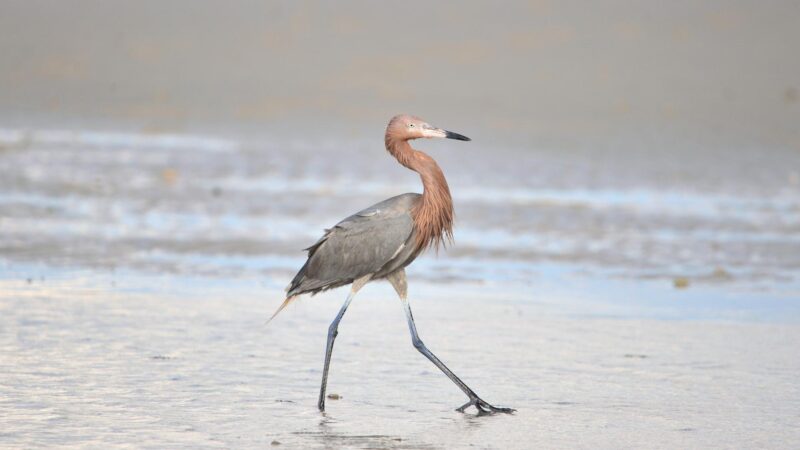
Populations of reddish egrets in the early 1800s were nearly wiped out as they were heavily hunted for their feathers. Today, there are about 1,500 to 2,000 thriving nesting pairs in the U.S., with most found in Texas. They are often found in wetlands and have long legs that allow them to take a wide variety of small aquatic prey.
- Scientific Name: Egretta rufescens
- Appearance: Medium-sized wading bird with a powerful body build, long neck, long legs, and a sharp, straight beak. The feathers located on its head and neck are often extended, giving it a shaggy look.
- Color: Two color phases: a dark morph and a white morph. A dark morph adult has a grayish blue body with a pinkish head and neck, while a white morph adult has a snowy white overall plumage. Both phases have a pink-based and black-tipped bill, as well as cobalt blue legs.
- Beak Length: 7.3 to 9.2 centimeters
- Lifespan: Up to 12 years
- Length: 68 to 82 centimeters
- Weight: 700 to 850 grams
- Diet: Mainly small fish such as sheepshead minnows, killifishes, and sailfin mollies. They seldom feed on crab and shrimp.
- Place Of Origin: Central America and Mexico
- Characteristics: Crepuscular (primarily active at dawn and dusk), usually nest in colonies, but some may be solitary, slightly territorial, and are mostly sedentary, with some populations migrating during the winter.
Whooping Crane
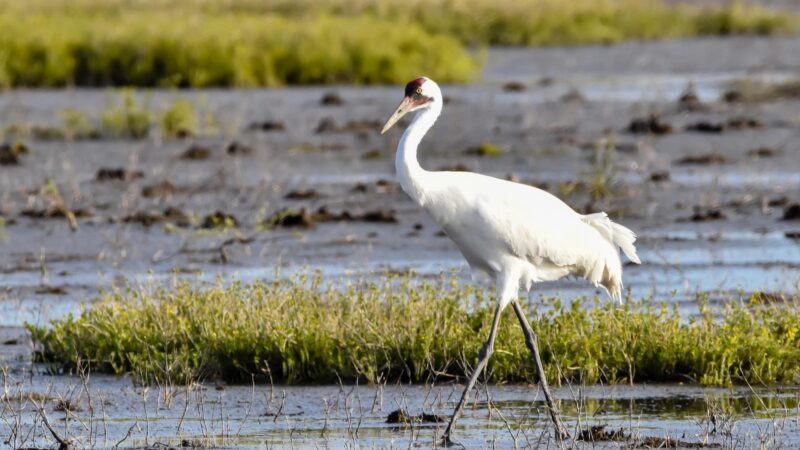
Known for being the world’s tallest flying bird, the whooping crane’s long legs are highly adapted to life in the wetlands. The scaly skin covering helps it dry during feeding or roosting in water. Moreover, its feet have long separated toes that help them easily navigate and wade through wetland vegetation and muddy surfaces.
- Scientific Name: Grus americana
- Appearance: Tall, large, but slender-bodied bird with a long neck, long legs, a stout and straight bill, and broad wings
- Color: Mainly white overall plumage with accents that range from bright red to black on its head. It has yellow eyes, gray or olive beaks with a pinkish base, black legs, and grayish-rose toes.
- Beak Length: 11.7 to 16 centimeters
- Lifespan: 22 to 30 years (wild), 35 to 40 years (captivity)
- Length: 130 to 160 centimeters
- Weight: 4.5 to 8.5 kilograms
- Diet: Mainly invertebrates (such as mollusks, crustaceans, frogs, and snakes), small-sized vertebrates (such as voles and mice), and plant material (such as berries, seeds, wheat, corn, and barley).
- Place Of Origin: North America
- Characteristics: Diurnal, mainly migratory but one of the three extant wild populations are sedentary, relatively social as they are usually found in pairs or small family groups, and territorial.
Purple Gallinule
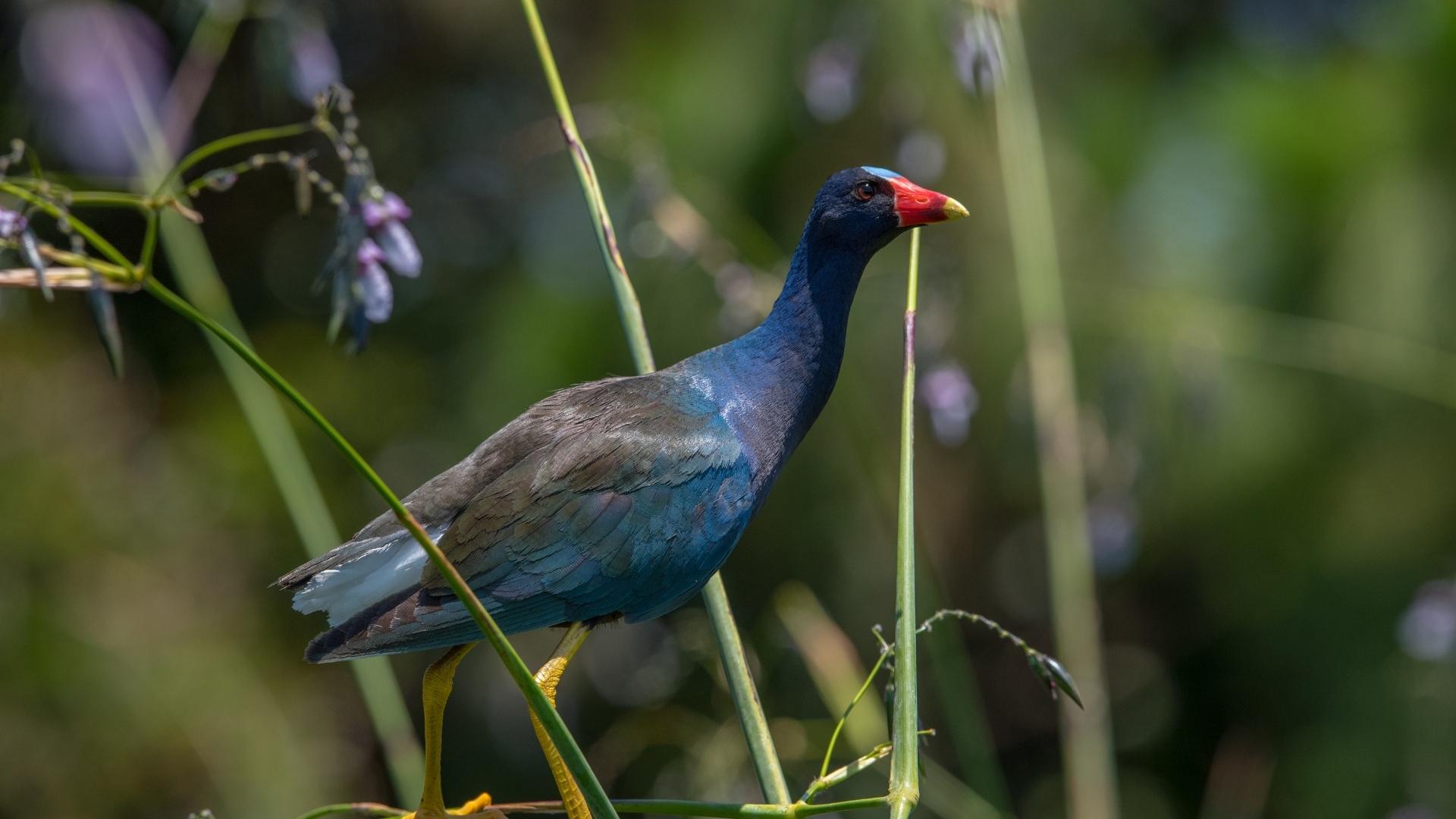
Purple gallinules are loud, colorful birds usually found in freshwater marshes. They have long legs and large, elongated toes used for walking on floating swamp plants in their habitats. They are known to walk slowly and carefully when foraging through vegetation for edible plants and animals.
- Scientific Name: Porphyrio martinica
- Appearance: Marsh bird that has a medium-sized and compact body, long legs and toes, a short tail that is usually cocked, and a heavy cone-shaped bill.
- Color: Purplish head and body with greenish wings and back plumage, a red bill with a yellow tip, baby-blue front plumage, white facial shield, and bright yellow feet and legs.
- Beak Length: 40.8 millimeters
- Lifespan: Up to 7 years (wild)
- Length: 33 to 37 centimeters
- Weight: 203 to 291 grams
- Diet: Primarily plants, such as those in the water-lily family, as well as tubers, leaves, and flowers of invasive exotic plants such as hydrilla and water hyacinth. They also prey on insects such as beetles, leeches, and grasshoppers, as well as small animals such as frogs and fish.
- Place Of Origin: Southeastern United States
- Characteristics: Nonbreeding areas are not territorial, although adults would seldom clash over territories. They are migratory, diurnal, and social birds, as they are usually found in flocks made up of 50 or fewer birds.
Gray Heron
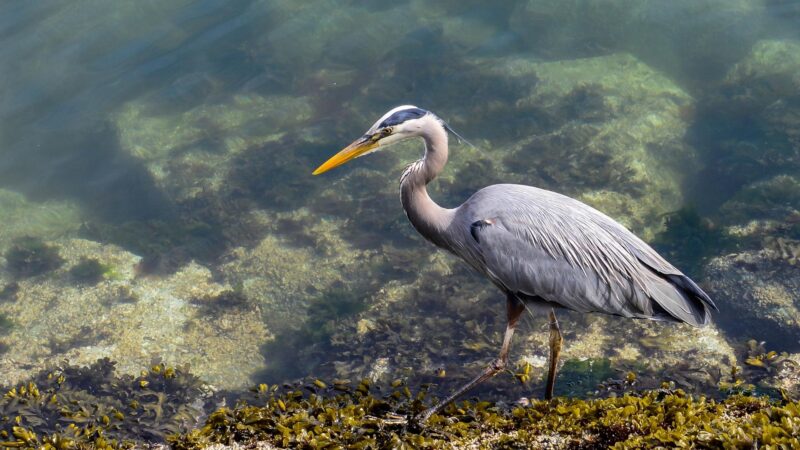
These long-legged wading birds use their beaks and even longer s-shaped necks to capture prey, typically by standing still and waiting for prey to approach them in the water. Once gray herons have their target locked, they swiftly capture their prey using their beaks before swallowing them whole.
- Scientific Name: Ardea cinerea
- Appearance: Fairly large bird with long feathers on its head, down to its eyes, and finally stopping at the beginning of its neck which ultimately forms a large crest. It has a long neck, long legs, and a dagger-like bill.
- Color: Mainly gray plumage that covers its dorsum, wings, and most of its neck. It has a white head, black extensive feathers, and a yellow bill that acquires an orange hue during the breeding season.
- Beak Length: 12 centimeters
- Lifespan: Up to 23 years (wild)
- Length: 84 to 102 centimeters
- Weight: 226 grams to 1.36 kilograms
- Diet: They are mainly piscivores, which means they eat fish, but they also feed on insects, crustaceans, frogs, and small mammals. They also consume small birds occasionally.
- Place Of Origin: Eurasia and Africa
- Characteristics: Aggressive, territorial, solitary except during the breeding season when the birds gather to increase their chances of finding potential mates, migratory and crepuscular
American Bittern
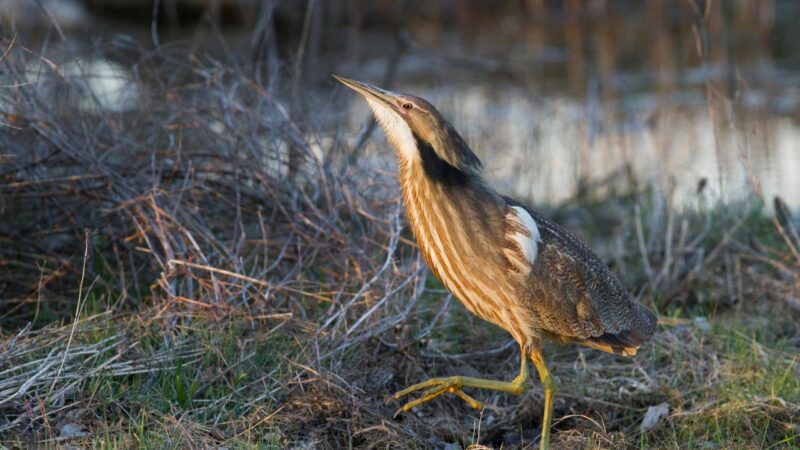
This cryptically-colored bird is difficult to see as its plumage allows it to blend with its surroundings. Despite having shorter legs compared to other wading birds, American bitterns use their legs to navigate slowly and elusively through dense marsh vegetation. When alarmed, they freeze up and point their bill straight upwards.
- Scientific Name: Botaurus lentiginosus
- Appearance: Medium-sized heron with a thick but compact body, long and thick neck, shorter legs compared to other herons, a long dagger-like beak, and broad wings. It has a slightly hunched posture.
- Color: Mostly buff, warm brown, and white plumage. Its upper sides are brown, which is speckled with black, while its undersides are heavily streaked, especially its neck, with white and brown. It also has a long, black patch from its eye down to the side of its neck.
- Beak Length: 4.89 to 7.67 centimeters
- Lifespan: Up to 8.3 years (wild)
- Length: 60 to 85 centimeters
- Weight: 370 to 500 grams
- Diet: Feeds on a variety of insects, fish, crustaceans, reptiles, amphibians, and small mammals. Common prey includes water beetles, grasshoppers, dragonflies, eels, killifish, catfish, crabs, frogs, salamanders, meadow voles, and water snakes.
- Place Of Origin: Canada, Northern and Central United States
- Characteristics: Solitary but forms minimal pair bonds, territorial, and diurnal. Northern populations are migratory, while southern populations are sedentary.
Scarlet Ibis
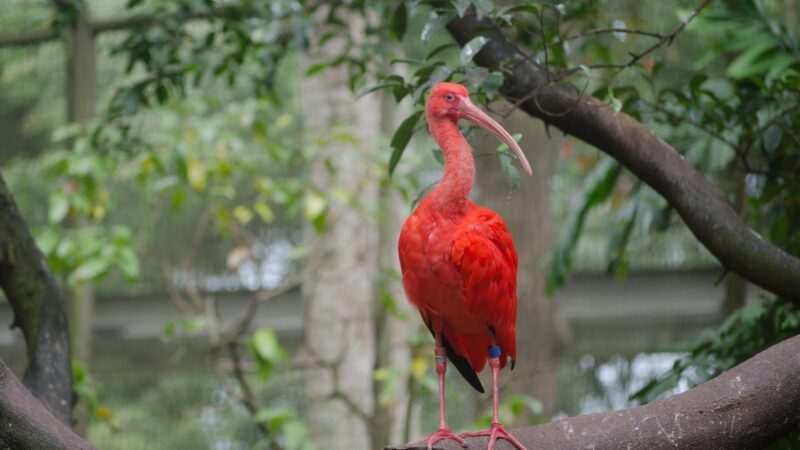
Hard to miss birds with their bright red plumage, Scarlet ibis have slender legs with large scales as well as partially webbed toes that they use to wade through shallow water and perch on trees. Additionally, their long necks and bill help them hunt for prey while they navigate through their habitats. They prefer inhabiting tropical regions with swampy environments such as mudflats and shorelines.
- Scientific Name: Eudocimus ruber
- Appearance: Medium-sized shorebird with long legs, long necks, a thin and downward-curving beak, and slightly webbed feet.
- Color: Bright red overall plumage with a lighter red shade on its head, neck, and underparts, blue-black wing tips, and black eyes and beak. However, only adults have this coloration. Juveniles are dull and have a grayish-brown plumage.
- Beak Length: 13.4 to 16.44 centimeters
- Lifespan: Up to 16 years (wild), Up to 31 years (captivity)
- Length: 55 to 76 centimeters
- Weight: 772 to 935 grams
- Diet: Primarily small crabs, crayfish, shellfish, and aquatic insects but they also feed on frogs, small snakes, small fish, and mollusks.
- Place Of Origin: South America and the Caribbean
- Characteristics: Diurnal, nomadic, territorial, and highly social during both nesting and foraging. They can also be seen flying in large flocks.
Jabiru

Jabirus are one of the largest and tallest flying birds in the world. Thanks to their long legs, they can walk through wetlands, freshwater marshes, and riparian habitats to forage for food. Additionally, they use their long beaks to probe in water at a 45° angle. They are also known to patrol their habitats by flying, usually in flocks.
- Scientific Name: Jabiru mycteria
- Appearance: Tall and large flying bird with a long and heavy beak, featherless head with a tuft of hair on the top, and a neck pouch
- Color: White plumage, a black head, and neck with a silver hair tuft resembling a mohawk, a red neck pouch, a skin band around the lower part of the neck that is deep pink in color but can turn deep scarlet when it becomes irritated, and black legs and feet.
- Beak Length: 30 centimeters
- Lifespan: Up to 30 years (wild), Up to 36 years (captivity)
- Length: 1.2 to 1.5 meters
- Weight: 4.3 to 9 kilograms
- Diet: Primarily fish, insects, mollusks, and amphibians, but they also consume small mammals and reptiles.
- Place Of Origin: South America
- Characteristics: Diurnal, social, sedentary but tend to move within their range to seek foraging areas and territorial.
American Flamingo

Known for their distinctive bright pink overall plumage, American flamingos are the largest flamingo species with long stick-like legs that are well-adapted to the harsh aquatic environment of alkaline lakes. They have tough leg skin that can withstand the corrosive concentration of carbonate salts in their natural habitats.
- Scientific Name: Phoenicopterus ruber
- Appearance: Tall and large bird with a slender body, small head, long and flexible neck, large bill, long legs, and small webbed feet.
- Color: Bright pink plumage overall, including its legs and webbed feet. It also has black feathers on the edges of its wings, which are only visible during flight.
- Beak Length: 22 to 30 centimeters
- Lifespan: Up to 30 years (captivity), Up to 44 years (wild)
- Length: 1.2 to 1.45 meters
- Weight: 2.1 to 4.1 kilograms
- Diet: Flamingos are not picky when it comes to food and can consume anything they capture through filter feeding. However, they usually end up eating crustaceans, organic ooze, nematodes, insects, small fish, worms, and mollusks.
- Place Of Origin: Caribbean Islands and the Northern coast of South America
- Characteristics: Social species that live in large flocks that could consist of thousands of members. Communication between members is essential. They can be both diurnal and nocturnal, depending on their feeding patterns. They are not territorial and are generally non-migratory but are known to move to warmer areas during winter.
Limpkin
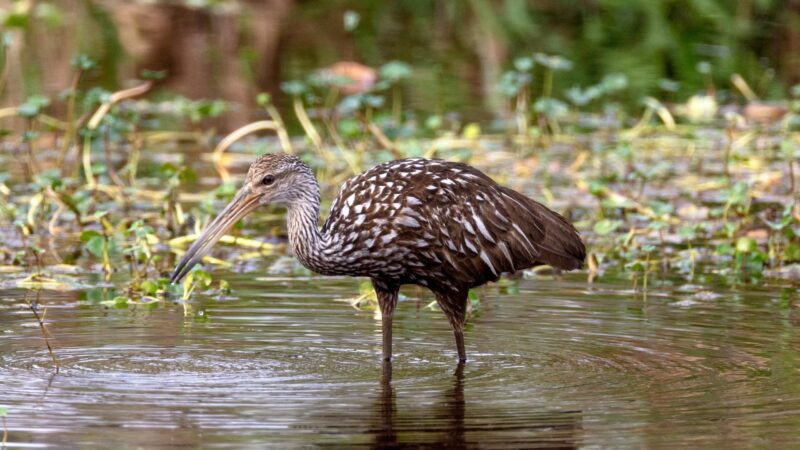
With no known close relatives in the animal kingdom, Limpkins are identified through their distinctive call, which is a high-pitched, repeated wail. This earned them the nickname the “Crying Bird.” They are commonly found in mangroves, swampy forests, and tropical marshes where they forage by walking through shallow water and probing among vegetation and in mud.
- Scientific Name: Aramus guarana
- Appearance: Tall and heavy-bodied bird with long legs, neck, and a slightly downward-curving bill
- Color: Uniform brown coloration overall with white streaks and spots on its back, neck, and wing coverts.
- Beak Length: Unknown
- Lifespan: Unknown
- Length: 63.5 to 72.9 centimeters
- Weight: 1.05 to 1.37 kilograms
- Diet: Freshwater snails (such as apple snails), seeds, insects, mussels, small reptiles and frogs, crayfish, and worms.
- Place Of Origin: Florida, Southern Mexico, Central America
- Characteristics: Solitary, non-migratory, but it moves around during wet and dry seasons, highly territorial and diurnal, but they also forage at nighttime.
Roseate Spoonbill
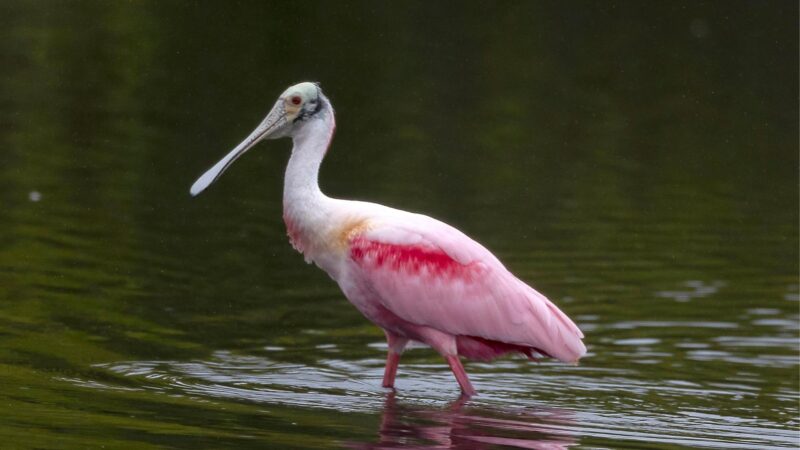
Roseate spoonbills are named after their distinguishable spoon-shaped beak and pink plumage. They use their long legs to walk through shallow water and forage by probing their bill underwater. During the flight, their necks and legs are fully extended. They usually sleep while standing on one leg with their heads tucked under their shoulders.
- Scientific Name: Platalea ajaja
- Appearance: Medium-sized waterbird with a body shaped like a football, small head, long legs, and a long flattened bill that resembles a spoon
- Color: Pale pink overall plumage with a white upper neck and back, light rose wings and under parts, deep carmine wings and tail coverts, and red irises and legs. Its head has some yellow-green flecks.
- Beak Length: 14.5 to 18 centimeters
- Lifespan: Up to 10 years (wild), Up to 15 years (captivity)
- Length: 71 to 86 centimeters
- Weight: 1.2 to 1.8 kilograms
- Diet: Primarily crustaceans such as shrimp and prawns. They also feed on aquatic insects and fish such as minnows.
- Place Of Origin: Southeastern United States, Central and South America
- Characteristics: A social bird is found feeding, roosting, and migrating in groups consisting of 2 to 400 individuals. It is also diurnal and territorial.
White-Faced Ibis
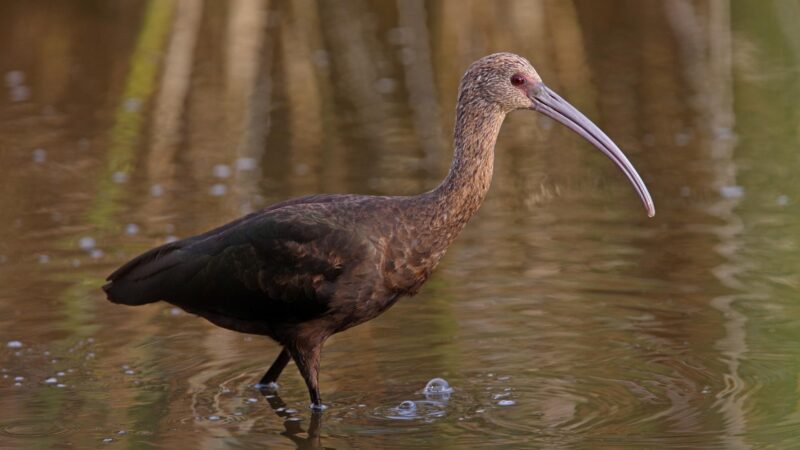
A shy and wary bird, the White-faced ibis is commonly found in mudflats, agricultural wetlands, and freshwater marshes where they use their long, sensitive bills to probe through the substrate. In North America, its population is threatened by the continuing drainage of wetlands and the excess use of pesticides.
- Scientific Name: Plegadis chihi
- Appearance: Medium-sized wading bird with an oval-shaped body, long neck and legs, a curved bill, and broad, rounded wings.
- Color: Maroon or brown coloration with dark green and bronze iridescent tones on the wings and undersides. It also has a white face, red eyes, and pinkish legs.
- Beak Length: 15 to 18 centimeters
- Lifespan: Up to 14 years (wild and captivity)
- Length: 46 to 56 centimeters
- Weight: 450 to 525 grams
- Diet: Primarily snails, slugs, clams, and earthworms, but they also feed on insects, spiders, crustaceans, leeches, and amphibians.
- Place Of Origin: America
- Characteristics: Social birds are commonly found in large flocks of up to 1,000 individuals. They are also nomadic, diurnal, and fairly territorial as they defend their nesting areas but will most likely not attack.
Wood Stork
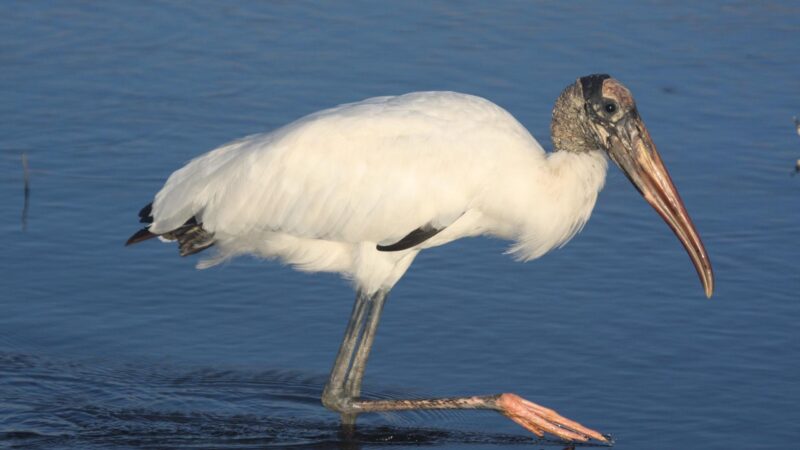
Wood storks are known as excellent fliers that are capable of soaring at altitudes reaching 300 meters. They are also incredible acrobats while descending as they perform rolls, turns, and dives along the way. They walk slowly through wetlands using their long legs as they forage for fish and crustaceans using their hefty beaks.
- Scientific Name: Mycteria americana
- Appearance: Large wading bird with a hefty, football-shaped body and long neck, legs, and a thick beak that is curved at the tip. When perched, it has a humpback-like appearance since it tends to draw in its neck.
- Color: Entirely white coloration except for its flight feathers and tail, which are black. Its head is featherless and looks like scales.
- Beak Length: 19 to 25 centimeters
- Lifespan: 11 to 18 years (wild), Up to 27 years (captivity)
- Length: 83 to 120 centimeters
- Weight: 2.5 to 3.3 kilograms
- Diet: Small fish, aquatic invertebrates, mollusks, insects, snails, and frogs.
- Place Of Origin: America
- Characteristics: Highly social birds that form small to large flocks. They are diurnal, migratory, and non-territorial, but males will initially show hostile behavior towards females before they accept them into their territory.
Tricolored Heron

Formerly called the Louisiana Heron, these birds are usually found in coastal habitats such as salt marshes, mangrove swamps, and estuaries. They adopt a stand-and-wait approach when capturing small fish, but they are also excellent at stalking and chasing them due to their long legs. Apart from gracefully walking, they are also able to pirouette with sharp turns and stops when navigating through wetlands.
- Scientific Name: Egretta tricolor
- Appearance: Medium-sized heron with a slim, delicate-looking body, long neck and legs, small head, and a long, dagger-shaped beak.
- Color: Has a rather colorful plumage that is a combination of lavender, blue-gray, and white. Breeding birds have white plumes standing out on the back of its head, a blue skin patch around its beak, and pink legs. On the other hand, nonbreeding birds will be duller in color and have yellowish legs.
- Lifespan: Up to 17 years (wild)
- Length: 25 to 30 centimeters
- Weight: 334 to 415 grams
- Diet: Primarily small fish such as killifishes and topminnows, but they also feed on crustaceans, amphibians, leeches, gastropods, spiders, worms, and insects.
- Place Of Origin: America
- Characteristics: Solitary when feeding but are found in large colonies when nesting. They are also migratory, highly territorial, and diurnal.
Snowy Egret
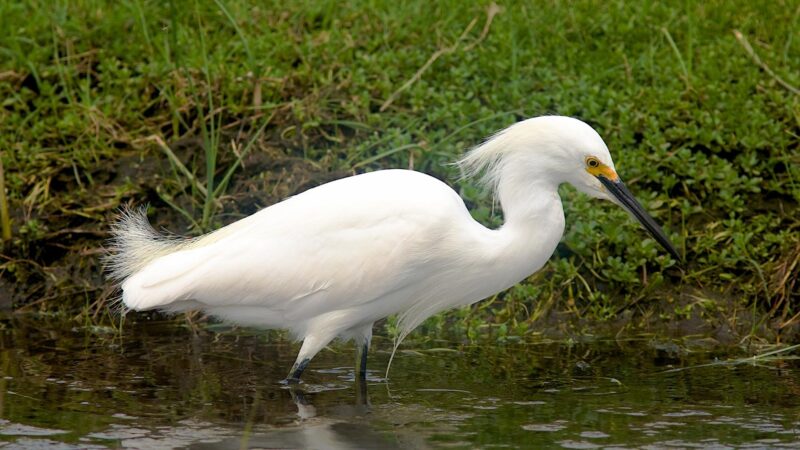
A small but elegant bird, snowy egrets were once heavily hunted in the late 1800s until the early 1900s for their plumes, which were twice the price of gold at that time period. Since the establishment of the Migratory Bird Treaty Act in 1918, their populations have since recovered. Today, they are commonly found around rivers, lakes, and ponds.
- Scientific Name: Egretta thula
- Appearance: Medium-sized body with a delicate build, long and thin legs, long and slender bill, long neck, and a small head.
- Color: White plumage overall, black beak and legs, yellow patch at the base of its beak, and bright yellow feet. Breeding adults have long plumes extending off their breast area and orange feet.
- Beak Length: 7.9 centimeters
- Lifespan: Up to 16 years (captivity), Up to 22 years (wild)
- Length: 56 to 66 centimeters
- Weight: 370 grams
- Diet: Primarily fish and crustaceans, but they also feed on earthworms, aquatic and terrestrial insects, snails, toads, snakes, and lizards.
- Place Of Origin: North, Central, and South America
- Characteristics: Crepuscular, highly social as they are usually found in groups with other species of aquatic birds, migratory, and fairly territorial
Cattle Egret
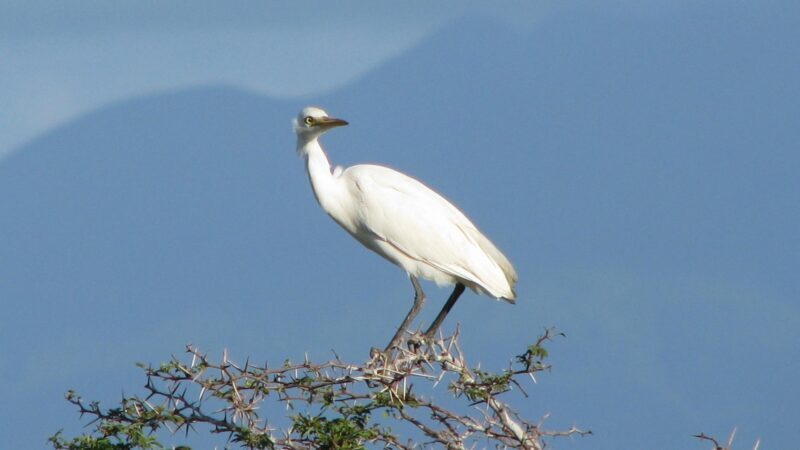
Cattle egrets are named after their behavior of following large animals and even farming equipment to forage for insects that fly around them. They can gather more food and use their energy more efficiently when they feed by associating with livestock than when feeding alone.
- Scientific Name: Bubulcus ibis
- Appearance: Small and compact bird with a hunched appearance, thick neck, short dagger-like bill, shorter legs compared to other herons, and medium-length but broad wings
- Color: Pure white coloration with a yellowish or pale orange bill, and dull orange legs. Breeding adults may briefly have buffy golden plumes at the head, back, and neck while their eyes, bill, and legs become a vivid red.
- Beak Length: 5.5 to 5.82 centimeters
- Lifespan: Up to 23 years (wild)
- Length: 46 to 56 centimeters
- Weight: 270 to 512 grams
- Diet: Primarily insects, such as crickets, grasshoppers, horse flies, cicadas, earthworms, centipedes, and millipedes, but they also feed on fish, mammals, frogs, and small birds.
- Place Of Origin: Africa and Southern Spain
- Characteristics: Highly gregarious as it can be seen associating closely with grazing animals and large colonies that can consist of other waterbird species. It is also migratory, non-territorial, and diurnal.
Green Heron
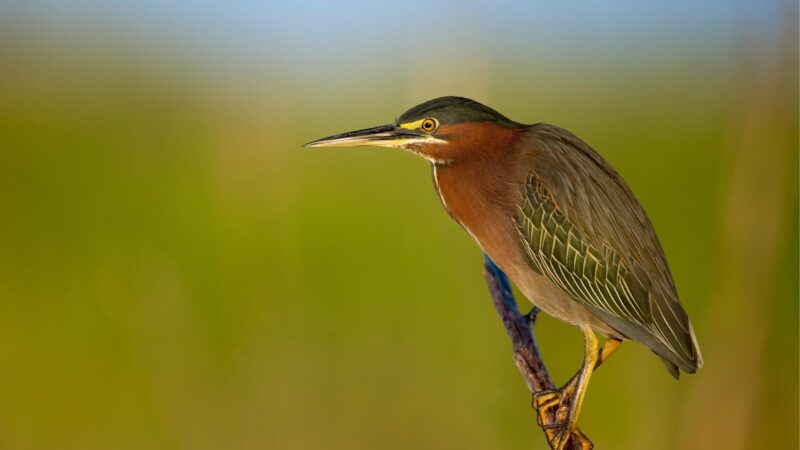
Shy and elusive birds that have a characteristic slow and deliberate walk, green herons are usually found foraging along shorelines of lakes and ponds, as well as streams. They are one of the few bird species that are known to use tools to attract prey, such as small sticks, feathers, and insects which they drop into the water and wait for fish to be in proximity before grabbing them.
- Scientific Name: Butorides virescens
- Appearance: Small heron with a stocky body, relatively shorter legs compared to other herons, a thick neck, broad and rounded wings, and long beaks.
- Color: Glossy deep green on the head cap and back, black to green gradient wings with blue edges, gray underparts, dark-colored bill, and orange legs. Female adult birds tend to have duller or lighter plumage than males, especially during the breeding season.
- Beak Length: 16 to 19 centimeters
- Lifespan: Up to 8 years (wild)
- Length: 41 to 46 centimeters
- Weight: 175 to 240 grams
- Diet: Mainly fish such as minnows, eels, catfish, and sunfish, as well as invertebrates such as dragonflies, leeches, waterbugs, and crayfish. They also feed on frogs, rodents, snakes, and lizards.
- Place Of Origin: North and Central America
- Characteristics: Diurnal, solitary, migratory, and territorial
Great Blue Heron
Considered the largest heron in North America, great blue herons are notorious for choking to death when trying to eat fish that are way too large for them to swallow. They are often misidentified as cranes and are usually found along streams, lakeshores, ponds, rivers, and occasionally on grassfields.
- Scientific Name: Ardea herodias
- Appearance: Large and tall bird with a long and sinuous neck, long legs, thick bill, broad and rounded wings, and plumes on the head wing, head, and chest, giving the bird an overall shaggy appearance
- Color: Blue-gray upper parts, white-gray plumes, dark blue-gray wings seen during flight, and reddish patches or black feathers on the flanks, sides, and thighs. Its legs range from yellowish-green to dark gray, while its necks range from white, rusty-red, to gray. Its crown and throat are white, while its eyes and beak are pale yellows.
- Beak Length: 14.2 centimeters
- Lifespan: Up to 23 years (wild)
- Length: 97 to 137 centimeters
- Weight: 2.1 to 2.5 kilograms
- Diet: Primarily fish, but they also consume salamanders, frogs, snakes, lizards, young birds, shrimps, crayfish, crabs, grasshoppers, dragonflies, and aquatic invertebrates.
- Place Of Origin: North and Central America
- Characteristics: Crepuscular but are also active in the mornings. They are solitary and extremely territorial, and most populations are migratory but southern populations are known to be sedentary.
Great Egret
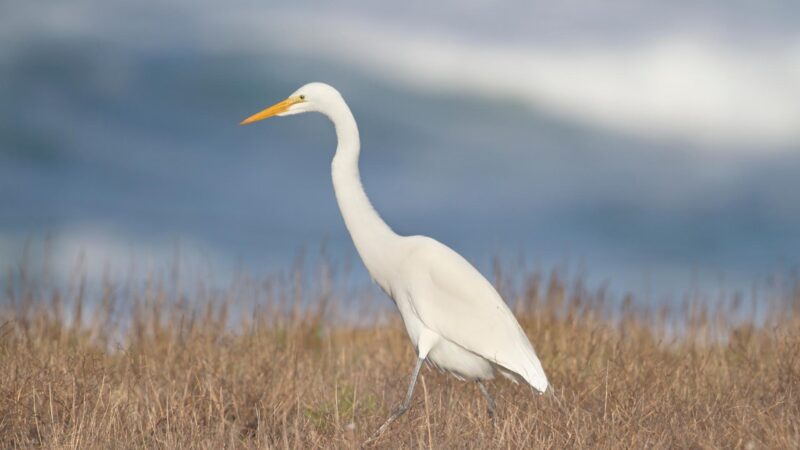
Found along rivers, ponds, and lakes, the great egret has changed its name several times in the past century. It is known to wade through wetlands when foraging or performing a sit-and-wait approach. They were hunted to the brink of extinction for their plumes in the late 19th century until they became widely protected.
- Scientific Name: Ardea alba
- Appearance: Tall wading bird with long legs, an S-curved neck, a dagger-like beak, and a short tail.
- Color: Completely white plumage resembling lace with dark gray legs and a yellow or yellowish-orange beak.
- Beak Length: 10.7 to 11.2 centimeters
- Lifespan: Up to 15 years (wild), Up to 22 years (captivity)
- Length: 94 to 104 centimeters
- Weight: 912 grams to 1.14 kilograms
- Diet: A typical diet includes frogs, crayfish, fish, aquatic insects, snakes, grasshoppers, prawns, mice, and other insects.
- Place Of Origin: America
- Characteristics: Highly territorial especially when it comes to feeding, courtship, and nesting. They are migratory and diurnal, but they are known to gather at dusk when roosting. Moreover, they are usually solitary birds except during mating season.
Long-legged birds usually belong to the groups of wading birds, herons, and shorebirds. They use their long legs to navigate through wetlands, marshes, and other freshwater to brackishwater habitats to forage for food. Additionally, they have long bills that allow them to probe underwater for fish and aquatic invertebrates such as crustaceans and worms.
List of Sources
Kirschbaum, K., Harris, M. S. (2000). Grus canadensis. Animal Diversity Web.
Esch, J. (2012). Grus americana. Animal Diversity Web.
Bower, J., Rabago, D. (2012). Ardea cinerea. Animal Diversity Web.
Harris, M. S. (1999). Botaurus lentiginosus. Animal Diversity Web.
Phelps, K. (2004). Eudocimus ruber. Animal Diversity Web.
